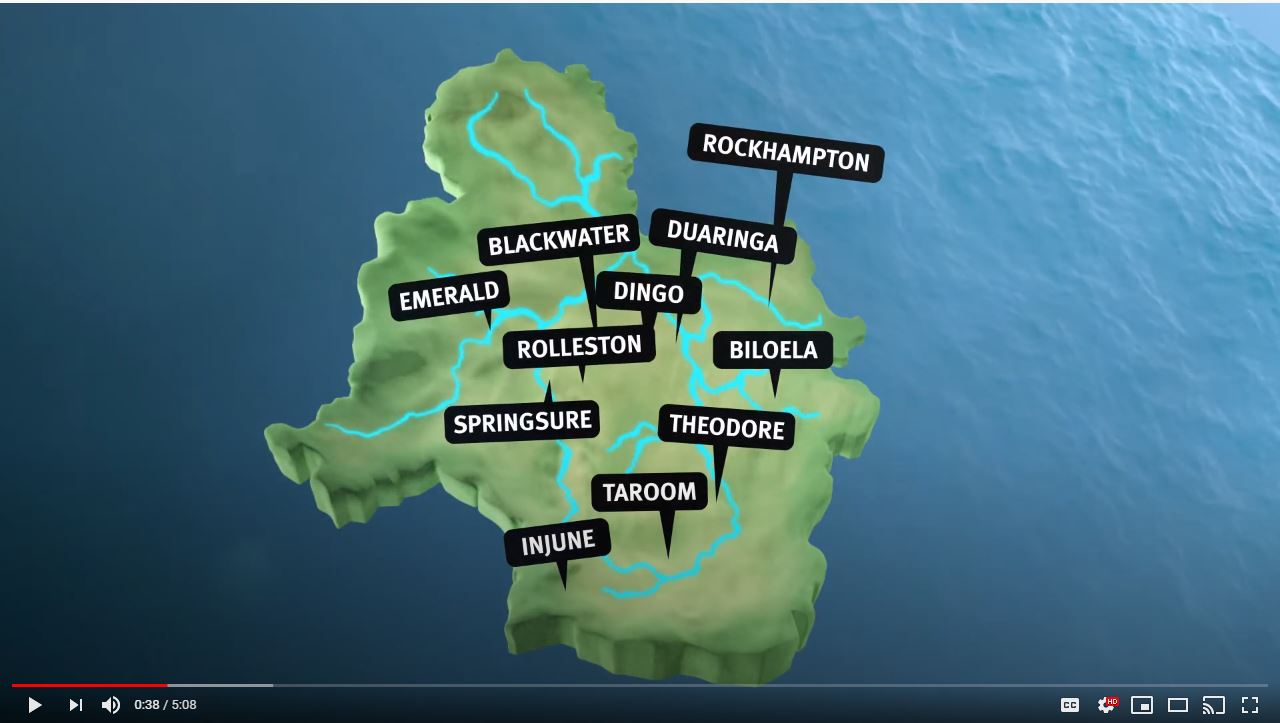Resources library - Flow Educational Resources
Flow Educational Resources Resources
Educational Video – Semi-evergreen Vine Thicket (SEVT)
Semi-evergreen Vine Thicket (SEVT) - Endangered Central Queensland Species - Educational Video

Semi-evergreen vine thicket (or SEVT), also known as bottletree scrub or softwood scrub, is a unique collection of trees and shrubs mixed with twining plants and vines (hence its name). Together the collection of living things (or ecological community) creates benefits for the CQ environment, animals, and humans! SEVT is the most biodiverse ecosystem in central Queensland. It is also the most carbon-dense ecosystem in central Queensland – storing large masses of carbon both above and below the ground. SEVT’s dense green mass of trees and vines is largely drought resistant. These features provide critical habitat and protection to native animals, safeguard people, homes and businesses from dangerous wildfires and improve the health and productivity of soil. It’s believed that SEVT covered more than 7 million hectares of Queensland and NSW at the start of the 20th century. Burning and clearing for agriculture have significantly reduced the amount of remaining SEVT. With less than 30% of the original SEVT remaining, the community is listed as endangered. Over the last four years we have been working with local land managers, First Nations People, local government and Queensland Parks and Wildlife Services to protect the remaining SEVT.
29/06/2023
Walking the Landscape Water Park Catchment Story
Water Park Catchment Story

To effectively manage the catchment it is important to have a collective understanding of how the catchment works. This map journal gathers information from experts and other data sources to provide that understanding.
11/08/2020
Fitzroy Region – Understand Your Flood Risk
Fitzroy Regional Resilience Strategy

Learn about the Fitzroy Basin in Central Queensland and understand your flood risk. The Fitzroy Basin includes eleven catchments, with their creeks and rivers flowing into the Fitzroy River and its estuaries eventually flowing out to the Great Barrier Reef. The Queensland Government has partnered with six councils to deliver the Fitzroy Regional Resilience Strategy, which uses a collaborative catchment approach for best practice management of flood warning infrastructure. The purpose of the Strategy is to provide a consistent and coordinated approach to manage flood warning infrastructure throughout the region that will enhance community safety and resilience. The Strategy has been developed in consultation with Central Queensland Regional Organisation of Councils (CQROC); Banana Shire Council; Central Highlands Regional Council; Isaac Regional Council; Livingstone Shire Council; Rockhampton Regional Council; Woorabinda Aboriginal Shire Council; with input from supporting stakeholder agencies including the Bureau of Meteorology, Fitzroy Basin Association and SunWater.
29/04/2020
Educational FBA paddock to reef resources
From paddock to the reef - a catchment is all connected

A catchment is an area where water is collected by the natural landscape. Water flows from the highest point of the catchment, like the hills or mountains, to the lowest points where it collects in rivers, creeks, lakes, wetlands or the ocean. No catchment is exactly like another. Each has a different size, shape and pattern of waterways. The way we use our land and water can impact the health of our catchments and the Great Barrier Reef (GBR).
03/07/2019
Fitzroy Basin awareness campaign 2017
Tilapia - Stop the Spread

Tilapia (Oreochromis mossambicus) is an aggressive pest fish regarded as one of the greatest threats to Australia’s aquatic ecosystem. They are a highly successful invasive species due to a number of key characteristics: rapid reproduction with maternal care, adaptable food requirements and tolerance for a wide range of aquatic habitats. Tilapia have progressively established populations in waterways throughout the south-east and northern Queensland and Western Australia since the 1970s.
01/07/2017
Additional funding leads to significant increase in hatching rates
Nest protection for vulnerable Fitzroy River Turtles

For over a decade, Fitzroy Basin Association Inc. (FBA) and Greening Australia have teamed together to protect iconic Fitzroy River Turtles from predation. However, by securing corporate partners to complement funding from the Australian Government’s National Landcare Programme, the two organisations have exponentially increased their nest protection efforts over the past two years.
14/06/2017
Improving fish passage in the Fitzroy Basin
Improving fish passage in the Fitzroy Basin

Many of our native fish species need to be able to migrate between fresh and salt water to complete their life cycle. Barriers such as roads, dams and weirs can prevent fish passage. Fitzroy Basin Association Inc. is working in priority areas across the Fitzroy Basin to improve fish passage by installing fish ways or fish ladders to allow access to upstream freshwater systems. In this video you can see two fishways we have installed, one at Moores Creek and the other at the Rockhampton Barrage. This work has been possible through funding from the Australian Government's Reef Program.
17/04/2017
Fitzroy River Turtle
Protecting Fitzroy River Turtle's Nests

Fitzroy Basin Association's (FBA) Cassandra Tracey and Greening Australia's Kymberly Robinson sharing the Fitzroy River Turtle story. Over 190 nests have been projected, more than double the previous year's result. This project is supported by Fitzroy Basin Assoication Inc through funding from the Australian Government's National Landcare Programme and the Santos GLNG project.
08/03/2017
Fish hotels
Yeppen Lagoon Fish Hotels

The Yeppen Lagoon had limited submerged large woody debris, which is necessary to provide both an important food source as well as habitat for the lagoon’s native freshwater fish. With the help of Rockhampton Regional Council, providing access to the site and through funding from the Australian Government’s Reef Programme, FBA installed 10 new fish hotels as habitat for juvenille fish. The hotels consist of interconnected and stacked hardwood log towers in one of the Fitzroy Floodplains largest and deepest lagoons, the Yeppen Lagoon. This project was supported by Fitzroy Basin Association, through the Australian Government's Reef Programme.
07/03/2017








